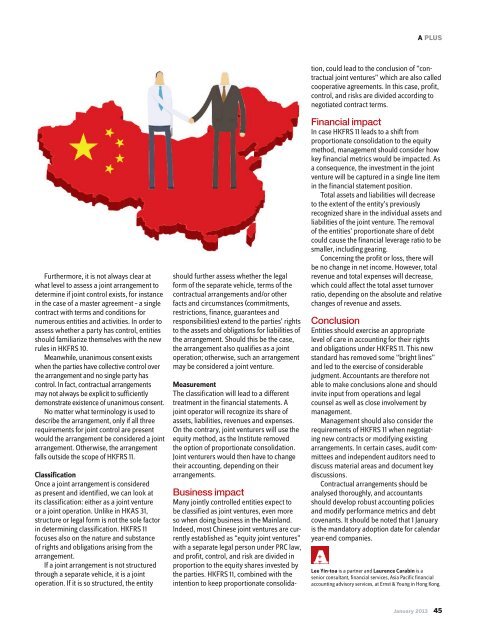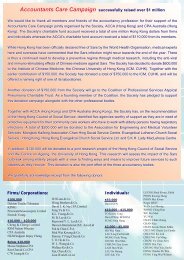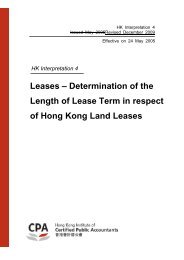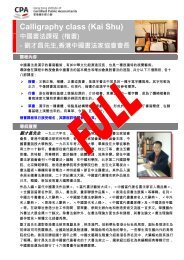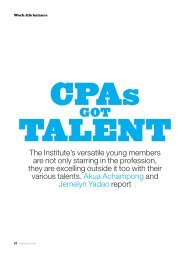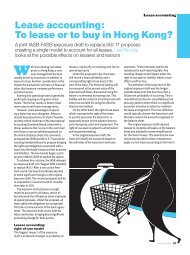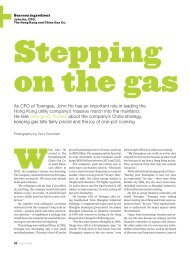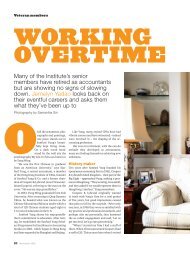The future of fashion - Hong Kong Institute of Certified Public ...
The future of fashion - Hong Kong Institute of Certified Public ...
The future of fashion - Hong Kong Institute of Certified Public ...
You also want an ePaper? Increase the reach of your titles
YUMPU automatically turns print PDFs into web optimized ePapers that Google loves.
Furthermore, it is not always clear at<br />
what level to assess a joint arrangement to<br />
determine if joint control exists, for instance<br />
in the case <strong>of</strong> a master agreement – a single<br />
contract with terms and conditions for<br />
numerous entities and activities. In order to<br />
assess whether a party has control, entities<br />
should familiarize themselves with the new<br />
rules in HKFRS 10.<br />
Meanwhile, unanimous consent exists<br />
when the parties have collective control over<br />
the arrangement and no single party has<br />
control. In fact, contractual arrangements<br />
may not always be explicit to sufficiently<br />
demonstrate existence <strong>of</strong> unanimous consent.<br />
No matter what terminology is used to<br />
describe the arrangement, only if all three<br />
requirements for joint control are present<br />
would the arrangement be considered a joint<br />
arrangement. Otherwise, the arrangement<br />
falls outside the scope <strong>of</strong> HKFRS 11.<br />
Classification<br />
Once a joint arrangement is considered<br />
as present and identified, we can look at<br />
its classification: either as a joint venture<br />
or a joint operation. Unlike in HKAS 31,<br />
structure or legal form is not the sole factor<br />
in determining classification. HKFRS 11<br />
focuses also on the nature and substance<br />
<strong>of</strong> rights and obligations arising from the<br />
arrangement.<br />
If a joint arrangement is not structured<br />
through a separate vehicle, it is a joint<br />
operation. If it is so structured, the entity<br />
should further assess whether the legal<br />
form <strong>of</strong> the separate vehicle, terms <strong>of</strong> the<br />
contractual arrangements and/or other<br />
facts and circumstances (commitments,<br />
restrictions, finance, guarantees and<br />
responsibilities) extend to the parties’ rights<br />
to the assets and obligations for liabilities <strong>of</strong><br />
the arrangement. Should this be the case,<br />
the arrangement also qualifies as a joint<br />
operation; otherwise, such an arrangement<br />
may be considered a joint venture.<br />
Measurement<br />
<strong>The</strong> classification will lead to a different<br />
treatment in the financial statements. A<br />
joint operator will recognize its share <strong>of</strong><br />
assets, liabilities, revenues and expenses.<br />
On the contrary, joint venturers will use the<br />
equity method, as the <strong>Institute</strong> removed<br />
the option <strong>of</strong> proportionate consolidation.<br />
Joint venturers would then have to change<br />
their accounting, depending on their<br />
arrangements.<br />
Business impact<br />
Many jointly controlled entities expect to<br />
be classified as joint ventures, even more<br />
so when doing business in the Mainland.<br />
Indeed, most Chinese joint ventures are currently<br />
established as “equity joint ventures”<br />
with a separate legal person under PRC law,<br />
and pr<strong>of</strong>it, control, and risk are divided in<br />
proportion to the equity shares invested by<br />
the parties. HKFRS 11, combined with the<br />
intention to keep proportionate consolida-<br />
A PLUS<br />
tion, could lead to the conclusion <strong>of</strong> “contractual<br />
joint ventures” which are also called<br />
cooperative agreements. In this case, pr<strong>of</strong>it,<br />
control, and risks are divided according to<br />
negotiated contract terms.<br />
Financial impact<br />
In case HKFRS 11 leads to a shift from<br />
proportionate consolidation to the equity<br />
method, management should consider how<br />
key financial metrics would be impacted. As<br />
a consequence, the investment in the joint<br />
venture will be captured in a single line item<br />
in the financial statement position.<br />
Total assets and liabilities will decrease<br />
to the extent <strong>of</strong> the entity’s previously<br />
recognized share in the individual assets and<br />
liabilities <strong>of</strong> the joint venture. <strong>The</strong> removal<br />
<strong>of</strong> the entities’ proportionate share <strong>of</strong> debt<br />
could cause the financial leverage ratio to be<br />
smaller, including gearing.<br />
Concerning the pr<strong>of</strong>it or loss, there will<br />
be no change in net income. However, total<br />
revenue and total expenses will decrease,<br />
which could affect the total asset turnover<br />
ratio, depending on the absolute and relative<br />
changes <strong>of</strong> revenue and assets.<br />
Conclusion<br />
Entities should exercise an appropriate<br />
level <strong>of</strong> care in accounting for their rights<br />
and obligations under HKFRS 11. This new<br />
standard has removed some “bright lines”<br />
and led to the exercise <strong>of</strong> considerable<br />
judgment. Accountants are therefore not<br />
able to make conclusions alone and should<br />
invite input from operations and legal<br />
counsel as well as close involvement by<br />
management.<br />
Management should also consider the<br />
requirements <strong>of</strong> HKFRS 11 when negotiating<br />
new contracts or modifying existing<br />
arrangements. In certain cases, audit committees<br />
and independent auditors need to<br />
discuss material areas and document key<br />
discussions.<br />
Contractual arrangements should be<br />
analysed thoroughly, and accountants<br />
should develop robust accounting policies<br />
and modify performance metrics and debt<br />
covenants. It should be noted that 1 January<br />
is the mandatory adoption date for calendar<br />
year-end companies.<br />
Lee Yin-toa is a partner and Laurence Carabin is a<br />
senior consultant, financial services, Asia Pacific financial<br />
accounting advisory services, at Ernst & Young in <strong>Hong</strong> <strong>Kong</strong>.<br />
January 2013 45


